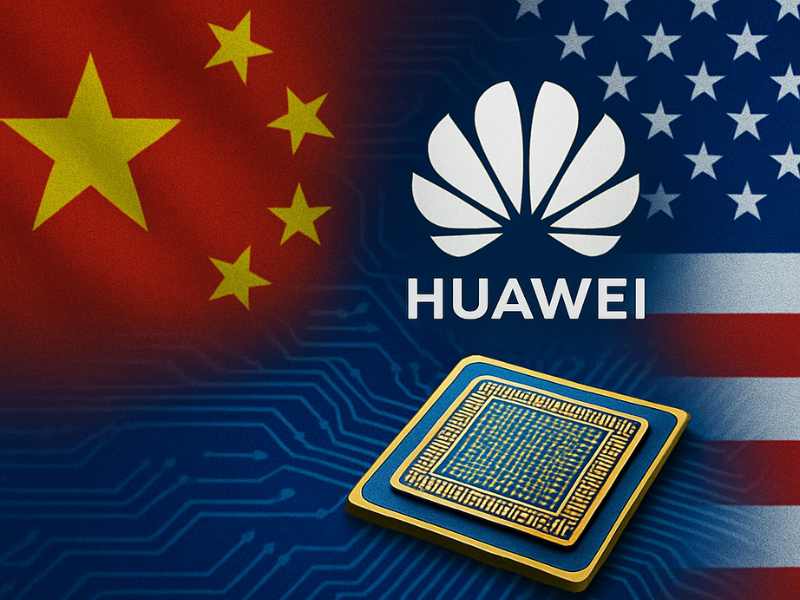As the United States intensifies restrictions on China’s access to cutting-edge semiconductors, Beijing is ramping up efforts to foster a homegrown AI chip ecosystem, with tech giant Huawei emerging as the country’s most promising hope.
The U.S. curbs go beyond merely blocking advanced AI chips from entering China — they limit access to vital technologies across the entire semiconductor value chain, from chip design and fabrication to memory and manufacturing equipment. These sweeping restrictions have left China scrambling to bridge technological gaps with domestic alternatives.
In response, the Chinese government has poured tens of billions of dollars into developing indigenous capabilities. While this aggressive investment has yielded some notable progress, experts say China is still far from rivaling global leaders like Nvidia.
Huawei Leads China’s AI Chip Charge
Among the key players, Huawei’s chip design arm, HiSilicon, has taken the lead with its Ascend series of GPUs. The latest in production, the Ascend 910B, and its successor, the 910C — expected to begin mass shipment this year — represent China’s most advanced efforts to close the AI chip gap.
Dylan Patel, chief analyst at SemiAnalysis, says Huawei has significantly narrowed the performance gap. “Compared to Nvidia’s export-restricted H20 chip, the Ascend 910C is only about a generation behind,” he said.
Yet, chip design alone won’t secure China’s AI future.
SMIC’s Fabrication Limits
Nvidia, though a leader in AI chip design, relies on Taiwan’s TSMC for manufacturing. But TSMC, along with other top global foundries, complies with U.S. export controls and cannot service Huawei or other blacklisted Chinese firms.
Instead, Huawei depends on SMIC (Semiconductor Manufacturing International Corp), China’s top chip foundry. While SMIC is believed to have produced a 5nm chip for Huawei’s Mate 60 Pro smartphone, it still lags far behind TSMC, which is already producing 3nm chips at scale.
“SMIC’s output and yield are not yet at the level where they can support Huawei’s GPU ambitions competitively,” said analyst Ray Wang.
EUV Machines — The Missing Link
Perhaps the most daunting challenge lies in manufacturing equipment. The Netherlands-based ASML, the world’s only supplier of extreme ultraviolet (EUV) lithography machines, is barred from exporting its top tools to China due to U.S. pressure.
Without access to EUV, Chinese firms must rely on older, less precise technologies. SMIC has attempted to “brute force” production at the 7nm level using deep ultraviolet (DUV) lithography. But yield rates remain poor, and experts warn the limits of this approach are near.
Chinese companies like SiCarrier Technologies are reportedly working on indigenous lithography solutions, possibly in partnership with Huawei. But Jeff Koch of SemiAnalysis cautions: “Building domestic EUV capability could take decades. China may instead seek alternative lithography innovations.”
The Memory Bottleneck
High-bandwidth memory (HBM), essential for AI chipsets, poses another barrier. South Korean firms SK Hynix and Samsung dominate this field, and Seoul now complies with U.S.-led restrictions on selling HBM chips to China.
Chinese memory maker ChangXin Memory Technologies (CXMT), in partnership with Tongfu Microelectronics, has begun early-stage development of HBM. But it remains to be seen how soon these efforts can yield commercially viable results.
The Road Ahead
Despite formidable challenges, China’s tech sector remains determined to reduce reliance on foreign technology. The government’s vast funding pool, coupled with national tech champions like Huawei, is gradually closing the gap in AI chip development.
“Export controls have created both pressure and opportunity,” said Paul Triolo of DGA-Albright Stonebridge Group. “China’s industry is responding — but progress will be uneven, and full independence is still years away.”
As geopolitical tensions reshape global tech supply chains, the battle over semiconductors is becoming the front line in the race for AI dominance.

